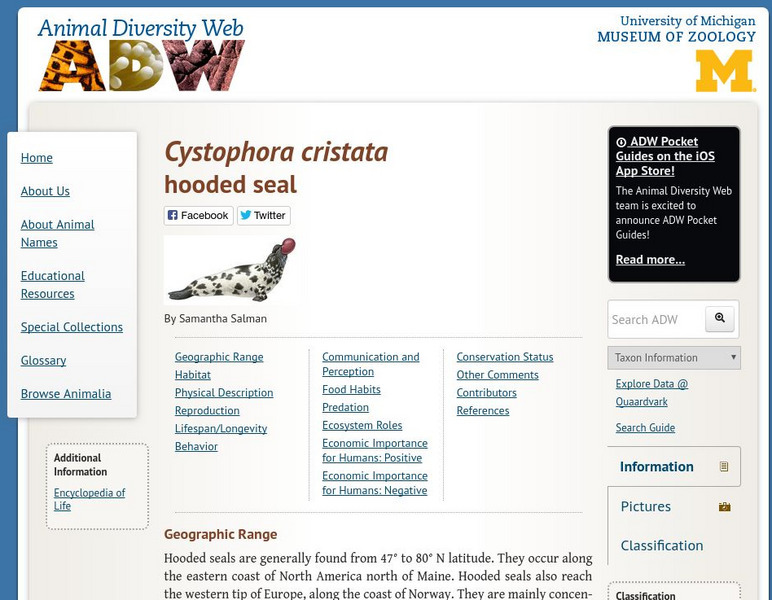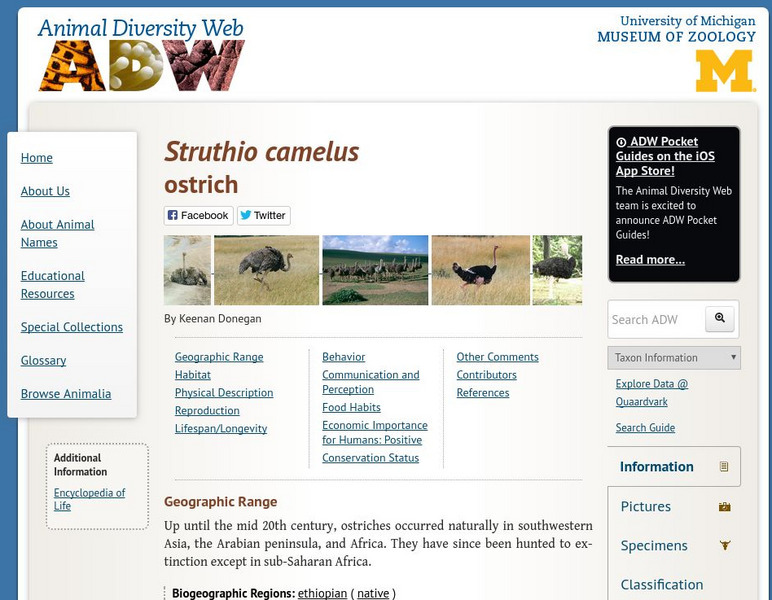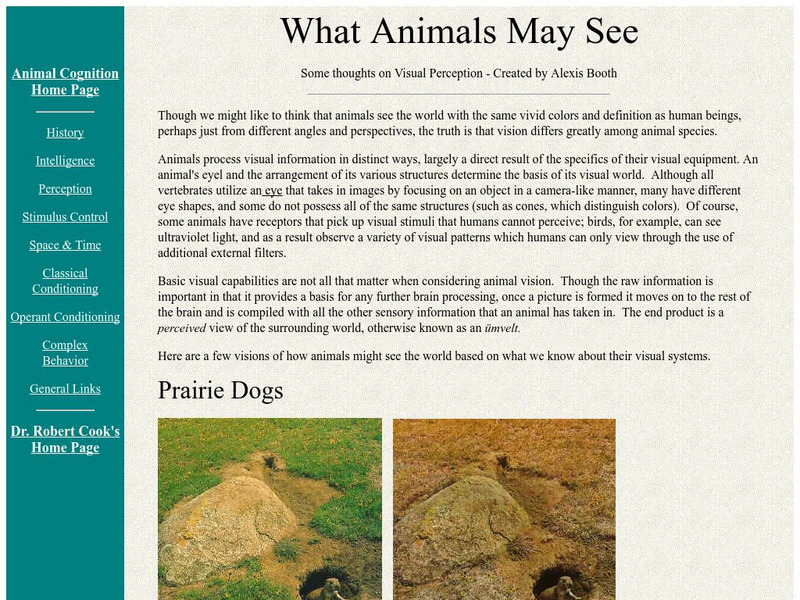Hi, what do you want to do?
TED Talks
Ted: Ted Ed: Inside the Ant Colony
Ants have one of the most complex social organizations in the animal kingdom; they live in structured colonies that contain different types of members who perform specific roles. Deborah M. Gordon explains the way these incredible...
TED Talks
Ted: Ted Ed: Social Animal
Tapping into the findings of his latest book, NYTimes columnist David Brooks unpacks new insights into human nature from the cognitive sciences- insights with massive implications for economics and politics as well as our own...
Regents of the University of Michigan
Animal Diversity Web: Pongo Pygmaeus (Orangutan)
Site contains information on the Pongo Pygmaeus (Orangutan). Includes geographic range, habitat, physical description, reproduction, behavior, food habits, and conservation status as well as other information and pictures.
Regents of the University of Michigan
Animal Diversity Web: Salamandra Salamandra (Fire Salamander)
Site contains information on the Salamandra Salamandra (Fire Salamander). Includes geographic range, habitat, physical description, reproduction, behavior, food habits, and conservation status as well as other information and pictures.
Physics Classroom
The Physics Classroom: Boundary Behavior
Educational tutorial features a physics tutorial on the behavior of sound waves specifically focusing upon boundary behavior. Be sure to view the attached animations for further understanding.
Sea World Parks & Entertainment
Sea World: Animal Bytes: Gorillas
This site from SeaWorld/Busch Gardens provides a wealth of information regarding gorillas. Content includes a focus on gorilla habitats and distribution, physical characteristics and special adaptations, senses, behavior, diet,...
Regents of the University of Michigan
Animal Diversity Web: Hooded Seal
A complete site that provides information on geographic range, habitat, physical description, reproduction, behavior, diet, economic importance, and the conservation status of the Hooded Seal.
Regents of the University of Michigan
Animal Diversity Web: Leopard Seal
This comprehensive site covers geographic range, habitat, physical description, reproduction, behavior, diet, economic importance (positive/negative), and conservation status.
Regents of the University of Michigan
Animal Diversity Web: Weddell Seal
This effective site provides information on geographic range, habitat, reproduction, behavior, diet, and economic importance.
Regents of the University of Michigan
Animal Diversity Web: Mediterranean Monk Seal
This thorough site examines the geographic range, habitat, physical description, reproduction, behavior, diet, economic importance (positive/negative), and conservation status of the Mediterranean Monk Seal.
Regents of the University of Michigan
Animal Diversity Web: Harbor Seal
Geographic range, habitat, physical description, reproduction, behavior, food habits, economic importance (negative/positive), and conservation status are all part of this complete site.
Regents of the University of Michigan
Animal Diversity Web: Ostrich
Topics delved into in this effective site are geographic range, habitat, physical description reproduction, behavior, diet, economic importance and conservation status.
A-Z Animals
A Z Animals: Animal Facts: Sea Otter (Enhydra Lutris)
Provides photographs and a fact card about the sea otter. Discusses where they are found, physical features, diet, predators, conservation status, the different species, social behavior, and mating behavior.
Alabama Learning Exchange
Alex: Nocturnal Animals Lesson #1
This lesson can be part of a two-week integrated thematic unit on nocturnal animals. During this lesson, young scholars will be introduced to nocturnal animals. They will have an opportunity to navigate web sites to learn more about...
Polk Brothers Foundation Center for Urban Education at DePaul University
De Paul University: Center for Urban Education: Animal Studies [Pdf]
"Animal Studies" is a one page, non-fiction, reading passage about studying the behaviors of animals including the sawfly and the poppy-bee. They learn about animals by observing them. It is followed by constructed-response questions...
Regents of the University of Michigan
Animal Diversity Web: Red Kangaroo
The Animal Diversity Web offers a page on the Macropus Rufus, or Red Kangaroo. Includes all kinds of information from behavior to history. Use the table of contents for easy navigation.
Regents of the University of Michigan
Animal Diversity Web: Peromyscus Eremicus (Cactus Mouse)
The Animal Diversity Web describes the natural history of the cactus mouse, including its geographical range, physical characteristics, natural habitat, reproduction, and behavior.
Other
Comparative Cognition Lab: What Animals May See
Animals process visual information in distinct ways and vision differs greatly among animal species. Take a look at what what different species of animals may see compared to what we as humans see.
Regents of the University of Michigan
Animal Diversity Web: Eurasian Moose
Comprehensive overview of the Eurasian moose, with information about physical characteristics, geographic range, diet, reproduction, behavior, and habitat.
Regents of the University of Michigan
Animal Diversity Web: Pronghorn
Comprehensive overview of the pronghorn antelope, with information about physical characteristics, geographic range, diet, reproduction, behavior, and habitat.
Regents of the University of Michigan
Animal Diversity Web: Ringtail
A detailed overview of the ringtail's characteristics, physical features, diet, behavior, and habitat. Included are some good photos and classification information.
Regents of the University of Michigan
Animal Diversity Web: American Bison
Comprehensive reference material on the American bison: its habitat, physical features, eating habits, reproduction, behavior, communication, roles in a prairie ecosystem, and interactions with humans.
Regents of the University of Michigan
Animal Diversity Web: Northern Fur Seal
Comprehensive reference material on the northern fur seal: its appearance, habitat, diet, behavior, reproduction, and its economic significance for humans.
Regents of the University of Michigan
Animal Diversity Web: American Beaver
Comprehensive reference material on the American beaver, with information about physical characteristics, classification, diet, reproduction, behavior, and habitat.
Other popular searches
- Animal Behavior Experiments
- Wild Animal Behavior
- Animal Behavior in Termites
- Animal Behavior of Fish
- Domestic Animal Behavior
- Animal Behavior Lesson Plans
- Biology Animal Behavior
- Animal Behavior Labs
- Animal Behavior Lab Betta
- Dance and Animal Behaviors
- Animal Behaviors Betta
- Innate Behavior Animal


























